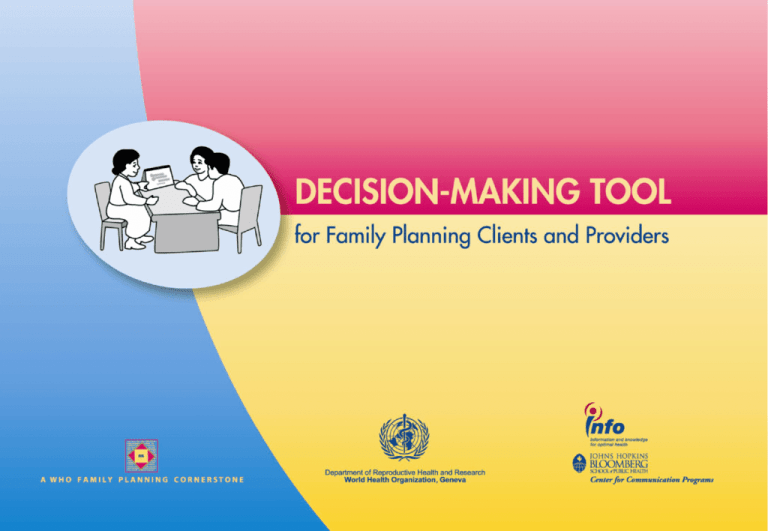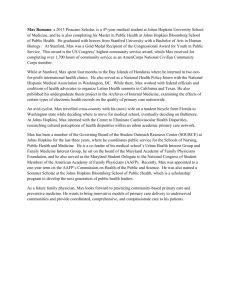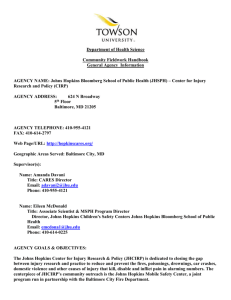
WHO Library Cataloguing-in-Publication Data
Decision-making tool for family planning clients and providers.
1.Family planning services 2.Contraception- methods 3.Counseling 4.Decision making 5.Teaching materials I.World Health Organization II.Johns Hopkins Bloomberg School of
Public Health. Center for Communication Programs.
Suggested citation: World Health Organization (WHO). and Johns Hopkins Bloomberg School of Public Health. Center for Communication Programs. Information and Knowledge for Optimal Health
(INFO). Decision-making tool for family planning clients and providers. Baltimore, Maryland, INFO and Geneva, WHO, 2005. (WHO Family Planning Cornerstone)
ISBN 92 4 159322 9
(NLM Classification: WA 550)
© 2005 World Health Organization and Johns Hopkins Bloomberg School of Public Health/Center for Communication Programs
All rights reserved. The publishers welcome requests to translate, adapt or reproduce the material in this document for the purpose of informing health care providers, their clients, and the general
public, as well as improving the quality of reproductive health care. Enquiries should be addressed to WHO Press, World Health Organization, 20 Avenue Appia, 1211 Geneva 27, Switzerland (fax: +41
22 791 4806; email: permissions@who.int). Authorized translations, adaptations and reprints may bear the emblem of the World Health Organization and the logo of the Johns Hopkins Bloomberg
School of Public Health/Center for Communication Programs.
Translations, adaptations and reproductions may be made without authorization so long as they are not used in conjunction with any commercial or promotional purposes, and so long as they do not
use the emblems of the World Health Organization and/or the Johns Hopkins Bloomberg School of Public Health/Center for Communication Programs or the INFO Project, and so long as they
acknowledge the original source in line with the suggested citation below. Neither the World Health Organization nor the Johns Hopkins Bloomberg School of Public Health/Center for Communication
Programs accepts responsibility for any translations, adaptations and reproductions published by others. The publishers request print and electronic copies of all translations, adaptations and
reproductions of this publication.
The mention of specific companies or of certain manufacturers’ products does not imply that they are endorsed or recommended by the World Health Organization in preference to others of a similar
nature that are not mentioned. Errors and omissions excepted, the names of proprietary products are distinguished by initial capital letters.
All reasonable precautions have been taken by the publishers to verify the information contained in this publication. However, the published material is being distributed without warranty of any kind,
either express or implied. The responsibility for the interpretation and use of the material lies with the reader. In no event shall the World Health Organization be liable for damages arising from its use.
Suggested citation for unofficial translations or adaptations of this tool: Translated/adapted from "Decision-Making Tool for Family Planning Clients and Providers" prepared by the World Health
Organization and the INFO Project at the Johns Hopkins Bloomberg School of Public Health/Center for Communication Programs. Geneva, World Health Organization, and Baltimore, Johns Hopkins
Bloomberg School of Public Health/Center for Communication Programs, 2005.
More copies of this tool and information on adaptation, training and translations can be obtained from:
The INFO Project
Johns Hopkins Bloomberg School of Public Health
Center for Communication Programs
111 Market Place, Suite 310
Baltimore, Maryland 21202, USA
Fax: +1 410 659 6266. Email: orders@jhuccp.org
Documentation Centre
Department of Reproductive Health and Research
World Health Organization
1211 Geneva 27
Switzerland
Fax +41 22 791 4189. Phone +41 22 791 4447. Email: rhrpublications@who.int
CD-ROMs and limited numbers of printed copies are available free of charge.
The document is also available online at:
• WHO’s Department of Reproductive Health and Research website http://www.who.int/reproductive-health/
• The INFO Project’s website http://www.infoforhealth.org/pubs/dmt
Decision-Making Tool
for Family Planning Clients and Providers
This tool constitutes one of the Four Cornerstones of WHO's evidence-based guidance in family planning. The technical content of this tool was developed using international
evidence-based family planning guidance, including Medical Eligibility Criteria for Contraceptive Use (WHO, Third Edition, 2004), Selected Practice Recommendations for
Contraceptive Use (WHO, Second Edition, 2005), and The Essentials of Contraceptive Technology (JHU/CCP 2003).
Acknowledgements:
This tool is a collaborative effort of the World Health Organization’s Department of Reproductive Health and Research and the INFO Project at Johns Hopkins Bloomberg School of
Public Health/Center for Communication Programs. The tool has been developed by Sarah Johnson, Ward Rinehart and Kathryn Church. Sharon Rudy also helped develop the
concept and initial drafts. Special thanks go to Kathryn Curtis, Carlos Huezo, Herbert Peterson, Annie Portela, James Shelton, Jennifer Smith and Paul Van Look for their support and
contribution to this work.
We would like to thank Young Mi Kim of the Johns Hopkins Bloomberg School of Public Health/Center for Communication Programs for her work in fieldtesting the tool, along with the
following individuals and organizations: Ilka Maria Rondinelli of the International Planned Parenthood Federation/Western Hemisphere Region, and its Member Association of Trinidad
and Tobago; Antonietta Martin of the Population Council and Frontiers in Reproductive Health, Mexico; Jenni Smit of the Reproductive Health Research Unit of the University of
Witwatersrand, South Africa; Dian Rosdiana of the Johns Hopkins University STARH Programme, Indonesia; and Michelle Heerey and Adrienne Kols of Johns Hopkins Bloomberg
School of Public Health/Center for Communication Programs. We would also like to thank the family planning providers in Indonesia, Mexico, Nicaragua, South Africa and Trinidad and
Tobago who participated in the fieldtesting. We also gratefully acknowledge Rafael Avila and Stephen Goldstein of the INFO Project for their help in production of this tool.
We would like to thank the following experts at WHO for their review and comments: Nathalie Broutet, Catherine d'Arcangues, Timothy Farley, Catherine Hamill, Rita Kabra, Svetlin
Kolev, Ornella Lincetto, Justin Mandala, Adriane Martin-Hilber, Francis Ndowa, and Jelka Zupan (Department of Reproductive Health and Research); Adepeju Olukoya and Claudia
Garcia-Moreno (Department of Gender, Women and Health); Tin-Tin Sint (Department of HIV/AIDS); Peter Weis (Family and Community Health Cluster); Yvan Hutin and Dina Pfeifer
(Department of Immunizations, Vaccines and Biologicals).
The tool is also based on expert advice from many international organizations in the field of family planning. We would like to thank the following interagency groups for their expert
reviews and guidance: the Client-Provider Interaction Subcommittee of the USAID MAQ Initiative, and the Expert Working Group to develop Selected Practice Recommendations for
Contraceptive Use. In addition, we would like to thank the following individuals for their crucial early input: Marcos Arevalo, Jeannette Cachan, Moshira El-Shafei, Pape Gaye, Mihai
Horga, Federico Leon, Shalini Shah, and Theresa Velasco.
Illustrations by Rita Meyer at the Johns Hopkins Bloomberg School of Public Health/Center for Communication Programs. Additional illustrations by Greg Dayman of Prographics, Inc.;
by the Reproductive Health Research Unit, Johannesburg, South Africa (images from page AP5 adapted from the Reproductive Health Flipchart); and by the Institute of Reproductive
Health, Georgetown University (pages FA3 and FA4).
Support for this project was provided by the United States Agency for International Development (USAID) (through the INFO Project from Global,
GH/PRH/PEC, under the terms of Grant No. GPH-A-00-02-00003-00), and by the governments of Japan, the Netherlands, Norway and Sweden.
Using the Decision-Making Tool for Family Planning Clients and Providers
Introduction for the Provider
This flip-chart is a tool for you and your client to use during family planning counselling. It can:
• help clients choose and use the method of family planning that suits them best;
• give you the essential information you need to offer high-quality family planning care to your clients;
• help you counsel clients more effectively.
About this Tool
Helping clients with different needs
•
In the front section there are different tabs for clients with differing
needs (also see flow-chart below):
•
•
The front section, covered by the tabs on the side, helps new
clients make decisions about a family planning method and helps
meet returning clients’ various needs. Counselling usually starts with
one of the side tabs.
The methods section, with the tabs at the bottom, provides
information for you and your client on each family planning method.
This information can help confirm a client’s choice and help the
client use a method correctly. Each method section includes
information on who can and cannot use each method, side-effects,
how to use the method, when to start, and what to remember.
•
•
The Appendices section, the last side tab, offers more counselling
aids that you can use as needed and reference pages on sexual and
reproductive health topics.
•
Principles of this “Decision-Making Tool”
1. The client makes the decisions.
2. The provider helps the client consider and make decisions that best
suit that client.
3. The client’s wishes are respected whenever possible.
4. The provider responds to the client’s statements, questions, and
needs.
5. The provider listens to what the client says in order to know what
to do next.
•
Choosing Method tab: New clients may need help to choose a
method that best suits their needs. This tab will help you discuss
these needs and help the client make a healthy choice.
Dual Protection tab: All clients need to consider dual
protection—protection from both sexually transmitted infections
(STIs), including HIV/AIDS, and pregnancy. STIs and HIV/AIDS
are a growing problem, and all clients should understand the
risk and decide how to protect themselves. At first, STI risk may
seem difficult to discuss, but actually, most clients welcome
such discussion. Consider how to introduce the topic without
expressing disapproval.
Special Needs tab: Clients with special needs include younger
clients, older clients, pregnant/postpartum clients, post-abortion
clients, clients living with HIV/AIDS, and clients who want to
become pregnant. These clients may have particular family
planning needs or need special advice or counselling.
Returning Clients tab: Clients returning to the clinic may be
having problems with their method, may have questions, or may
simply want more supplies. This tab can help you address their
needs.
Introduction for the Provider
i
Tab
Using the Tool with different
types of clients
Welcome client
This is a summary of the key steps you
usually follow with the various types of
family planning clients. Start here:
Tab
Find out reason for visit
Go to correct tab
Tab
Choosing Method
(for new clients)
Ask client:
Do you have a
method in mind?
If method in
mind:
If no method
in mind:
Check if
method suits
needs and
situation.
Check dual
protection
needs.
Discuss needs
and situation
and review
method options.
Check dual
protection
needs.
Dual
Protection
(for clients who
need STI
protection)
Discuss options
for dual
protection.
If needed, help
client consider
risk. Check if
chosen option is
suitable.
Tab
Tab
Tab
Clients with
Special Needs
Emergency
Contraception
(method tab)
Returning Client
Ask what method client
is using:
Go to method page in
Returning Client section
Go to correct
page in section:
• Younger client
• Older client
• Postpartum/
pregnant client
• Post-abortion client
• Client living with
HIV/AIDS
• Client who wants to
become pregnant
No problems
with method.
Problems using
method.
Help manage
side-effects.
Check for new
health conditions.
Check about need
for STI protection.
Client had
unprotected sex,
needs emergency
contraception.
Switch method
Go to Choosing
Method tab (side)
or Method tab
(bottom)
Method Tabs
Note: Some
method sections
do not have all
these pages.
Overview &
information for choice
Medical
eligibility criteria
Possible
side-effects
How to
use
Introduction for the Provider
When to
start
What to
remember
Provide
method
ii
Preparing to use this Tool
How to use this Tool with clients
•
•
•
•
•
•
•
Studying this tool will help you become familiar with how it works
and with the information in it. Using the flip-chart will become
easier with practice.
If this is your own personal copy, you may wish to write in it,
adding things to say or other reminders.
•
This guide covers only the main points. When you talk with
clients, you can add information and discuss matters further,
responding to the client’s needs and concerns.
Some words and pictures on the client’s pages may not apply in
your programme. You can cover them or cross them out. For
example, you may not have every family planning method that is
pictured.
You can and should use your own words. In general, the text is
not meant to be read to the client. Once the guide becomes
familiar, a glance will remind you of key information and your
next steps. Do not try to read the small type while counselling.
However, you may want to read aloud and discuss some key
points on the client’s pages. If the client cannot read well, you
may need to read more. Point to pictures if that is helpful.
•
•
•
Counselling icons
Many pages have small icons (symbols) on them. These icons will
remind you of good counselling behaviour that is especially
important at that moment. Here are the icons:
Listen
carefully
Check
understanding
Offer
support
Ask if client
has questions
•
The Tool stands up so both you and the client can see the
pages on each side. Your page shows the same words that the
client sees but not the pictures. Instead, your page has more
information and suggestions for you.
Place the Tool where the client can
easily see it. Try not to place the
flipchart directly between you and
the client. You can place it to the
side or where both of you look
at the client’s side.
Tell the client about the Tool. Explain that it will help meet
her or his needs.
For every client, start with the Welcome page, which follows
this introduction. After you welcome the client, you turn to the
next page. Here you ask the client how you can help. The
client’s answer usually will lead you to one of the side tabs.
These pages may then lead you to a contraceptive method
tab at the bottom.
To use the tabs, place your fingertip against the tab and
slide it under the page in front of the tab. Then flip over all
the pages. Do not lift the page with the tab on it.
Each page shows the client an important question or topic. To
use this tool correctly, you usually need the client’s
answers or information before you can go to the next page.
You can tell the client this. Then the client will know that her or
his participation is important. The diagram below (page iv)
shows how to use the provider's pages.
Introduction for the Provider
iii
How to use the provider's pages
Shows which method section you are in.
Glance here for
reminder of main
point to address
now.
The Pill
Provider’s
information (blue
boxes): Suggested
questions, phrases,
actions, information
for reference and
study ahead.
Possible side-effects
If you choose this method, you may
have some side-effects. They are not
usually signs of illness.
•
•
•
•
“It can take time for the body to adjust.”
Different people have different reactions to methods.
About half of all users never have any side-effects.
Side-effects often go away or lessen within 3 months.
• But many women do not have any
Glance here.
Discuss these
points with client as
needed.
The blue boxes on
the right have more
information and
suggestions.
• Often go away after a few months
Most common:
• Nausea (upset stomach)
• Spotting or bleeding between periods
• Mild headaches
• Tender breasts
• Slight weight gain or loss
Discuss:
• “If these side-effects happened to you, what
would you think or feel about it?”
• “What would it mean to you?”
• “What would you do?”
• Discuss any rumours or concerns.
See Appendix 10 on myths.
• "Please come back any time you want help or have
questions."
• “It is okay to switch methods any time.”
• For dealing with side-effects, see Returning Client tab.
Icon: Reminder of
good counselling
practice.
“Suggested
words you might
use.”
• Tell client: skipping pills may make bleeding sideeffects worse and risks pregnancy.
Next Move:
Look here for
your next move
based on client’s
statements.
Does client understand side-effects? Is she ready to choose method?
If she has decided to use method,
go to next page.
Picture of decision-making client:
This picture reminds you that the client
needs to make a decision or say what
she/he prefers before moving on.
If not, discuss further or consider other
methods.
P3
Page numbering:
All tabbed sections are numbered separately,
with a letter or letters to indicate the section. For
example P3 is Pill section, page 3.
The other side of this page is the client’s first page.
Please flip to next
page for Welcome
iv
Welcome
Using this flipchart, we can help you:
• Choose and use a method
• Solve any problems
• Get accurate information
Please tell me about:
• Yourself
• Your needs
• Your questions
We promise you privacy
and confidentiality





